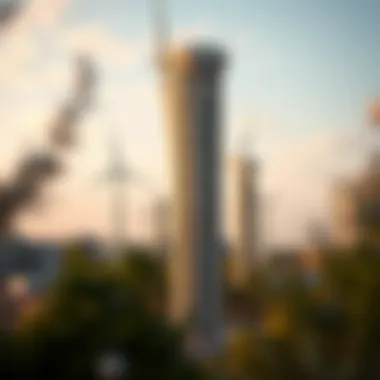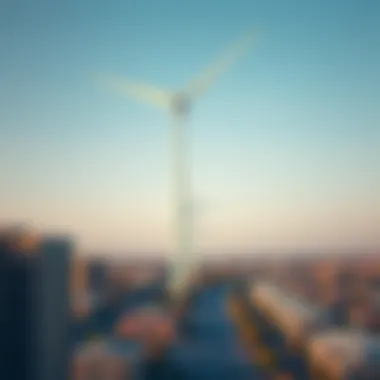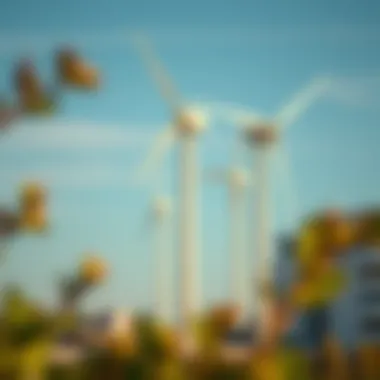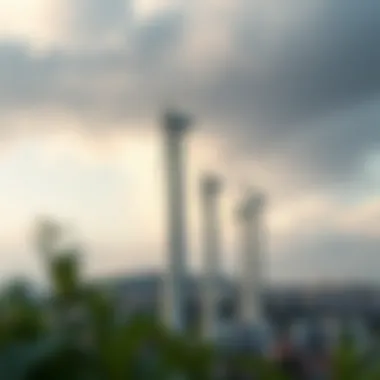Exploring Wind Towers in Sustainable Architecture


Intro
Wind towers have long been a hallmark of architectural ingenuity, particularly in the harsh, sun-bleached landscapes of arid regions. These structures, designed to capitalize on natural ventilation and cooling, stand as a testament to human adaptability and our evolving understanding of sustainable living. As modern architects and urban planners increasingly pivot towards green design, wind towers are experiencing a renaissance. The reasons for this resurgence are manifold: they offer solutions to pressing environmental concerns, present a unique aesthetic appeal, and can provide effective cooling without relying heavily on energy-consuming technologies.
In this discussion, we will delve into the role that wind towers play within the framework of sustainable architecture, emphasizing both their historical context and their potential in contemporary urban settings. By exploring their functional properties, design principles, and the materials that build them, we also aim to shed light on their contribution to sustainable living. Furthermore, with a focus on Dubai's real estate sector, we’ll illustrate how such architectural elements are not just relics of the past but integral components of modern living.
So, let’s embark on this exploration of wind towers—where tradition meets innovation, and sustainability finds its footing in the structures we inhabit.
Preamble to Wind Towers
Wind towers, also known as wind catchers or badgirs, represent a captivating confluence of ancient architectural wisdom and modern environmental consciousness. They have stood the test of time, serving not merely as decorative elements, but as highly functional constructs that harness natural resources in a sustainable manner. The significance of wind towers extends beyond their aesthetic appeal; they embody principles that are particularly relevant in today's discussions on sustainable architecture.
In arid climates, the need for effective cooling solutions is paramount. Traditional air conditioning systems often come with hefty energy bills and environmental costs. This is where wind towers shine by providing a natural and cost-effective means of cooling. They channel breezes through strategically placed openings, allowing air to flow into living spaces below, significantly reducing indoor temperatures without consuming energy.
Moreover, wind towers also serve as timeless reminders of cultural identity, representing a blend of functionality and craftsmanship. As urban landscapes evolve, the incorporation of wind towers into modern architectural design illustrates how we can embrace history while progressing towards sustainability. The need to blend traditional methods with contemporary building practices is gaining traction, especially among homebuyers, investors, and developers looking for innovative solutions that honor heritage while advancing energy efficiency.
Why Are Wind Towers Important?
- Natural Cooling: They utilize natural wind patterns to cool spaces, minimizing reliance on energy-intensive HVAC systems.
- Cultural Heritage: They reflect the architectural heritage of regions, particularly in the Arab world, demonstrating a rich history in adaptation to local climates.
- Sustainability: Wind towers align perfectly with sustainable practices, encompassing environmental efficiency while reducing carbon footprints.
- Innovative Design: Modern adaptations of wind towers showcase the potential for blending functionality with aesthetic design.
In this article, we will explore the historical context of wind towers, their cultural significance, and the mechanics behind their operation. Understanding these aspects will provide insights into how wind towers can address contemporary challenges in sustainable urban living. Let us embark on this journey into the fascinating world of wind towers.
Mechanics of Wind Towers
Understanding the mechanics of wind towers is crucial for appreciating their role in sustainable architecture, particularly in regions characterized by arid climates. Beyond mere aesthetics, these structures serve as vital components that enhance the indoor climate while minimizing energy consumption. Their design intricacies directly correlate with how effectively they harness and redirect natural airflow within buildings, creating comfortable and livable spaces without relying heavily on mechanical systems.
How Wind Towers Function
Wind towers, sometimes referred to as wind catchers, are designed to capture cool breezes from above and channel them down into the living spaces of a building. The fundamental principle guiding their operation is relatively simple yet exceptionally effective:
- Venturi Effect: When wind encounters a structure, it experiences variations in pressure. The design of wind towers often incorporates narrower passages or openings that accelerate the airflow, effectively lowering the pressure and drawing cool air into the building.
- Stack Effect: As warm air rises, it creates a natural vacuum. Wind towers exploit this natural phenomenon, allowing fresher air to flow in from below. This is particularly beneficial in hot climates, where the indoor temperature can skyrocket without proper ventilation.
Wind towers can also include adjustable vents to control airflow even further, depending on environmental conditions or occupant needs.
Airflow Dynamics: Understanding the Principles
The manipulation of airflow is paramount to the functionality of wind towers. Designers must consider several key factors:
- Orientation: The positioning of wind towers significantly influences their efficiency. Ideally, they should face the prevailing winds to maximize their effectiveness in directing airflow.
- Height: Taller structures tend to capture wind currents more effectively, taking advantage of the natural uplift experienced at greater elevations. This also helps in mixing cooler ambient air with warmer indoor air.
- Material Selection: The choice of materials can impact the thermal properties of a wind tower, affecting how much heat is absorbed or dispelled. For instance, using lighter colored materials can reflect more sunlight, keeping the tower cooler and enhancing its ability to draw warm air upwards.
It is essential that architects and engineers work hand-in-hand to refine these dynamics, ensuring that each tower is tailored to its specific environment and purpose.
Thermal Regulation through Ventilation
Effective thermal regulation is another crucial aspect of how wind towers contribute to sustainable architecture. They operate as natural ventilation systems, reducing the need for artificial cooling methods like air conditioning. By leveraging natural temperature gradients, wind towers facilitate:
- Reduced Energy Costs: Utilizing wind as a cooling mechanism can lead to significant reductions in energy consumption for heating or cooling systems, which is vital for homeowners, tenants, and real estate developers alike.
- Indoor Air Quality Improvement: Continuous airflow not only maintains comfortable temperatures but also helps in expelling stale air and reducing humidity, creating a healthier indoor environment.
- Climate Adaptation: As cities take steps towards sustainability, wind towers offer an ingenious method to adapt to changing climate conditions, allowing buildings to remain livable despite rising temperatures.
"Wind towers represent a fusion of ancient wisdom and modern technology, breathing new life into the architecture of today."


By educating potential buyers, observers, and real estate stakeholders about these mechanics, we can better advocate for the incorporation and appreciation of wind towers in urban planning and design.
Design Strategies for Wind Towers
When contemplating the integration of wind towers into contemporary architecture, it becomes clear that there are various design strategies that must be diligently considered. These strategies not only enhance the aesthetic value of buildings but also significantly affect their energy efficiency and environmental impact. With the increasing awareness of sustainability issues, the importance of effective design strategies is greater than ever. In this section, we will explore several key aspects of wind tower design, analyzing how they can shape future architectural practices.
Architectural Design Considerations
Integrating wind towers into modern buildings involves more than just adding a traditional element. It requires a thoughtful approach towards architectural design. For instance, one must consider the orientation of the wind tower in relation to prevailing winds. Proper positioning can maximize airflow, providing natural ventilation even during the hottest months. Moreover, the overall aesthetic appeal should marry function with form; visual harmony with the rest of the structure is crucial.
It’s also essential to consider the scale of the wind tower. A towering design can overshadow its surroundings and appear ungracious, while a smaller version may not provide sufficient airflow. Here are some points to keep in mind:
- Contextual Harmony: Ensure that wind towers blend well with the surrounding architecture.
- Proportion and Scale: The height and dimensions must cater to local conditions and architectural styles.
- Functionality: Prioritize designs that facilitate easy maintenance and ensure effective airflow.
Incorporating these considerations can greatly aid in the effective application of wind towers, contributing significantly to both building functionality and visual impact.
Materials Selection for Efficiency
The choice of materials can make or break the efficiency of wind towers. With an eye on sustainability, architects must select materials that not only reflect the innovative spirit of modern construction but also promote thermal comfort. Traditional materials like clay and stone have their place, but new-age options such as recycled metals or composites can offer significant benefits.
When deliberating on material selection, consider the following factors:
- Thermal Properties: Materials that reflect heat can keep interiors cool.
- Durability: Wind towers are subjected to environmental stressors; long-lasting materials are vital.
- Local Availability: Sourcing materials locally not only reduces transport emissions but also supports local economies.
An efficient wind tower, constructed from the right materials, can tend to its environmental responsibilities while enhancing the aesthetic contours of a modern building.
Integration with Modern Buildings
Melding wind towers with modern architecture calls for a seamless synergy between the old and new. The challenge lies in coupling these historical structures with advancements in technology and design. As urban areas become increasingly crowded, the need to optimize space becomes paramount. Wind towers can serve as both functional and decorative elements within tight urban settings.
Key points to explore during this integration include:
- Urban Context: Analyzing the environment and urban geography can determine the most effective placement for wind towers.
- Technological Adaptation: Integrating sensors and smart technologies can optimize airflow.
- Community Engagement: Involving local communities in the design process can enhance acceptance and effectiveness.
Utilizing a harmonious design strategy in integrating wind towers with modern architecture ensures that they contribute positively, both functionally and aesthetically, to urban spaces. By adapting these historic structures to fit contemporary lifestyles, we tap into a treasure trove of sustainable benefits that can redefine urban living.
"Design that integrates nature can enhance our living environments while promoting sustainability and comfort."
Case Studies of Wind Towers in Dubai
The exploration of wind towers in Dubai highlights their vital role in the integration of sustainable practices within modern architecture. As urban settings continue to expand, understanding how iconic structures utilize wind towers can help real estate developers and homebuyers recognize the benefits these designs bring. Not only do these towers offer respite from the heat, but they also present a case for energy efficiency that aligns with global sustainability goals.
Iconic Structures Utilizing Wind Towers
Several landmark buildings in Dubai showcase the effective use of wind towers. A prime example is the Al Bahar Towers, which brilliantly combines traditional influences with contemporary design. This set of towers incorporates dynamic wind catchers that not only cool indoor spaces but also enhance the aesthetic appeal of the skyline. The adaptability of these towers to the harsh desert climate makes them a stunning feature along with their functional benefits.
Another example is the Burj Khalifa, which, while primarily known for its height, employs ventilation principles akin to those found in wind towers. This integration ensures a continuous flow of fresh air throughout different levels of the building.
Additionally, the Masdar City development in Abu Dhabi, though slightly separate from Dubai, serves as a model of wind tower design. Here, a system of wind towers captures breezes from different directions, channeling airflow where it is needed most, showcasing a commitment to renewable energy while minimizing reliance on mechanical systems.


Performance Metrics of Wind Towers in Urban Settings
When evaluating the effectiveness of wind towers in urban environments, specific performance metrics are crucial. Airflow and thermal comfort are two primary measures of success.
- Airflow Efficiency: Research has shown that wind towers can improve ventilation rates significantly. For instance, in the case of the Al Bahar Towers, airflow simulations indicated an average indoor airflow rate of up to 30% better when wind towers are employed compared to standard HVAC systems.
- Reduction in Cooling Loads: The cooling loads in buildings utilizing wind towers are significantly lower. Constructed buildings have achieved energy savings ranging from 20% to 40% compared to traditional cooling systems.
- Thermal Comfort Index: Evaluating occupant comfort levels demonstrates a marked improvement. Surveys conducted in buildings like the Burj Khalifa show that occupants report enhanced comfort during peak heat periods due to effective air distribution.
By analyzing these performance metrics, we see the impact wind towers have not just on sustainability but also on occupant well-being.
"Through careful analysis of case studies, it's evident that wind towers are not merely relics of old architecture, but essential components in modern sustainable design, enhancing energy efficiency and user comfort alike.”
As Dubai paves the way toward an eco-friendly future, the practical application of wind towers serves as a remarkable testament to architectural innovation and sustainable living.
Impact on Sustainability and Energy Efficiency
Wind towers play a crucial role in driving sustainability and enhancing energy efficiency within urban architecture. In a world grappling with climate change and energy scarcity, these structures emerge as a beacon of hope. They not only maximize the use of natural resources but also minimize reliance on mechanical systems, thus addressing pressing environmental challenges. The importance of this topic in the context of sustainable architecture cannot be overstated; as cities expand and populations grow, innovative solutions are needed.
Reducing Energy Consumption
One of the most significant advantages of wind towers is their ability to substantially reduce energy consumption. By harnessing the natural flow of air, these architectural features can effectively cool indoor environments without the need for traditional air conditioning systems. This method, sometimes referred to as 'passive cooling,' allows buildings to maintain comfortable temperatures.
The operational mechanics are simple yet effective. Wind towers collect cool breezes from the environment and facilitate airflow through indoor spaces. According to various studies, this can lead to a reduction of up to 30% in energy use compared to conventional air conditioning methods. This not only translates to lower utility bills for occupants but also contributes to a decrease in greenhouse gas emissions generated by energy production.
Moreover, the ambient temperature in arid regions is often hot and dry, especially during summer months. Wind towers take advantage of this climate by drawing in cooler air, which can create a refreshing breeze indoors.
Some key benefits include:
- Lowering dependency on fossil fuels: Using natural airflow lessens the need for energy-intensive cooling methods.
- Enhancing indoor air quality: Continuous airflow reduces humidity levels and improves overall air circulation, creating healthier living environments.
- Cost-effectiveness: Reduced energy consumption results in lower operational and maintenance costs for property owners.
Comparison with Traditional HVAC Systems
When comparing wind towers with traditional HVAC (Heating, Ventilation, and Air Conditioning) systems, the differences become glaringly obvious. Traditional HVAC systems are often energy-hungry, requiring significant amounts of electricity to operate. In contrast, wind towers provide ventilation and cooling by leveraging natural forces, reaffirming their status as a sustainable alternative.
A few notable distinctions between the two systems include:
- Energy Efficiency: While HVAC systems require electrical inputs that can fluctuate in cost and availability, wind towers operate mainly without these dependencies. The energy savings can be significant, especially in regions with high electricity costs.
- Initial and Operational Costs: The initial investment in HVAC systems may be considerably higher due to installation complexity. Wind towers typically have lower upfront expenses and reduced operational costs over the building's lifespan.
- Flexibility in Design: Wind towers can be integrated into various building designs, particularly in traditional and modern architecture alike. HVAC systems sometimes require specific configurations that could limit design flexibility.
To summarize, incorporating wind towers into modern architecture allows for increased sustainability and energy efficiency. By significantly reducing energy consumption and providing a compelling alternative to traditional HVAC systems, they mark a pivotal development in efforts towards greener living spaces. As the focus on sustainable architecture continues to grow, wind towers will undoubtedly play an essential part in shaping the future of urban development.
Challenges in Implementing Wind Towers
Implementing wind towers in contemporary architecture is not without its obstacles. Despite their proven benefits in energy efficiency and thermal comfort, architects and developers face several challenges. Understanding these challenges is essential for anyone engaged in sustainable building practices, be it homebuyers, investors, or real estate agents.
Design Limitations in Modern Architecture
In the fast-paced world of modern architecture, where aesthetics often take precedence, wind towers can sometimes be sidelined due to practical design limitations.
- Structural Constraints: Wind towers need a robust framework to withstand varying wind pressures. Integrating these structures into modern designs, which often prioritize sleek lines, can be tricky. Architects might find themselves compromising on the height or size of the towers to fit into a contemporary style.
- Integration with Building Systems: In buildings with complex mechanical systems, accommodating wind towers can create conflicts. Traditional designs and modern technology rarely work hand-in-hand. It requires innovative thinking and an open mind to incorporate wind towers seamlessly into existing layouts.
- Cultural Reinterpretations: As architects blend local heritage with modern needs, the traditional aesthetics of wind towers may not be well received. In cultures that value modernity over tradition, convincing stakeholders to adopt these structures can present a significant hurdle.
"While the benefits of wind towers are clear, integrating them into today's architectural trends requires a delicate balance between tradition and innovation."


Regulatory Barriers in Urban Development
The implementation of wind towers is often limited by regulatory frameworks that aren't always in sync with sustainable architecture practices.
- Building Codes and Compliance: Various local and municipal building codes can restrict the height and design of any added structures, including wind towers. Navigating these codes can be a daunting task for developers, hindering progress on projects that could benefit from such innovative solutions.
- Zoning Regulations: Depending on the area, zoning laws might dictate what can and cannot be built. In densely populated urban environments, the push for maximizing space often overshadows the advantages of integrating wind towers. Developers face the challenge of negotiating these regulations while promoting sustainability.
- Public and Stakeholder Consultation: Gaining community support is crucial for any development project. Sometimes, the general public may have misconceptions about wind towers, viewing them as outdated or ineffective. Overcoming this public relations hurdle can require significant effort and communication strategies.
These challenges, while considerable, also present an opportunity for innovation. By tackling these limitations head-on, architects, developers, and urban planners can pave the way for wind towers to be an integral part of sustainable architecture.
Future Perspectives and Innovations
The landscape of architecture is ever-evolving, marked by shifts in design philosophy, technological integration, and sustainability considerations. Wind towers, often regarded as relics of ancient design, can significantly contribute to future architectural innovations, particularly in urban settings. Understanding the potential that lies in optimizing these structures offers a vision for a more sustainable future, creating energy-efficient, environmentally sound buildings that marry form with function.
Emerging Technologies in Wind Tower Design
With the onset of new materials and engineering advancements, wind tower design finds itself at the forefront of architectural innovation. Technologies like computational fluid dynamics (CFD) allow architects to simulate air flow in and around structures. This enables them to optimize the height, shapes, and placements of wind towers to maximize their efficiency. By understanding airflow patterns, designers can develop wind towers that not only harness natural breezes but also enhance the overall comfort of the indoor spaces.
Additionally, the use of materials like transparent solar panels and kinetic glass can transform traditional wind towers into multi-functional organic entities that generate energy while maintaining their primary role of ventilation. These high-tech components provide durability and adaptability, allowing buildings to respond dynamically to environmental changes.
Here are some notable technological advancements:
- Smart Sensors: Monitoring indoor air quality and adjusting airflow accordingly.
- Adaptive Design: Structures that can change shape or function based on weather conditions.
- Integration with IoT: Connecting wind systems with smart home devices for enhanced control.
"With the integration of smart technologies, wind towers could become an adaptive element of urban living that caters to changing climates and user needs."
Trends in Sustainable Architecture
As the world continues to face climate challenges, the push towards sustainable architecture is more relevant than ever. One notable trend is biophilic design, which emphasizes the connection between nature and built environments. Wind towers fit perfectly within this framework, acting as natural ventilation systems while promoting healthier living spaces.
Moreover, there is a growing focus on passive design strategies, where buildings are constructed to utilize natural climate cues. Wind towers, in this context, serve as vital conduits for cooling and airflow. Their traditional implementation is being revisited, aiming to blend the wisdom of ancient structures with modern innovations.
Lastly, as urban areas become more densely populated, the need for vertical gardens and green roofs—they can be complemented by wind towers—is increasing. This not just beautifies the skyline but creates a symbiotic relationship with nature, improving air quality and promoting biodiversity within city limits.
Key trends influencing the future of wind towers in sustainable architecture include:
- Focus on Energy Efficiency: Prioritizing designs that make the most of natural resources.
- Emphasis on Local Materials: Reducing transportation emissions and supporting local economies.
- Community-Centric Designs: Emphasizing buildings that serve as hubs for social interaction.
Overall, the innovations and trends surrounding wind towers mark a pivotal shift towards a more sustainable architectural future, beckoning homeowners, investors, and developers to rethink traditional approaches and embrace the potential embedded in the old knowledge. This allows for the preservation of cultural identity while paving the way for modern necessities.
End
The concluding section of this article serves to encapsulate the major themes discussed regarding wind towers and their relevance within the realm of sustainable architecture. Wind towers are not merely aesthetic elements, but rather pivotal components in enhancing energy efficiency, particularly in arid zones. Their significance has surged in recent years, paralleling the global movement toward greener, more sustainable design.
Summary of Findings
Throughout the exploration of wind towers, several key points emerged:
- Functional Versatility: Wind towers are designed to naturally ventilate buildings. By utilizing the principles of airflow dynamics, these structures can maintain a comfortable indoor climate without relying heavily on mechanical systems.
- Cultural and Historical Insight: Their roots trace back to ancient civilizations, particularly within Arab architecture, demonstrating a rich historical context that ties modern practices to earlier methodologies.
- Modern Innovations: Advances in materials and technology have revitalized interest in wind towers, allowing them to integrate seamlessly with contemporary architectural designs. Innovations such as photovoltaic panels and smart sensors further enhance their utility.
- Case Studies and Applications: Practical examples from Dubai highlight wind towers’ effectiveness, showcasing their ability to dramatically reduce energy consumption and improve indoor air quality in high-density urban settings.
The Role of Wind Towers in Future Urban Landscapes
Looking ahead, wind towers highlight a potential evolution in urban development. As cities grow denser and climate concerns escalate, the need for sustainable practices becomes more pressing. Wind towers not only promise to enhance energy efficiency but can also serve as a symbolic commitment to sustainable living. Their implementation could lead to:
- Resilient Infrastructure: By incorporating wind towers into building designs, urban planners can create resilient communities that adapt more effectively to natural climate patterns.
- Regulatory Emphasis: With a greater emphasis on energy-efficient buildings, regulations around sustainable construction may favor designs that include natural ventilation solutions like wind towers.
- Community Awareness and Engagement: Educational initiatives showcasing the benefits of wind towers can foster public interest and support for sustainable architecture. This shift can inspire both developers and homebuyers to prioritize energy-efficient features in their projects and purchases.
In summary, as urban landscapes continue to evolve, the integration of structures like wind towers could redefine the experience of city living. They encapsulate a blend of tradition and innovation, affirming that sustainable architecture is not just a trend, but a necessity for our collective future.



